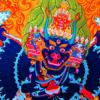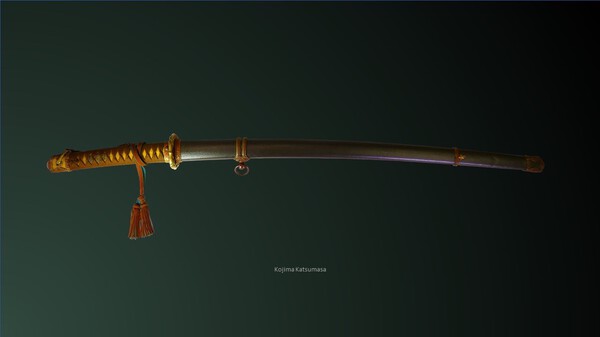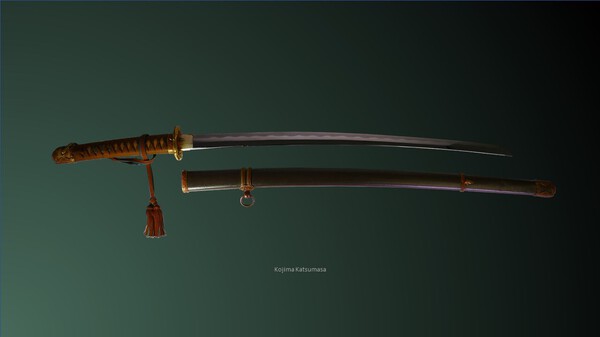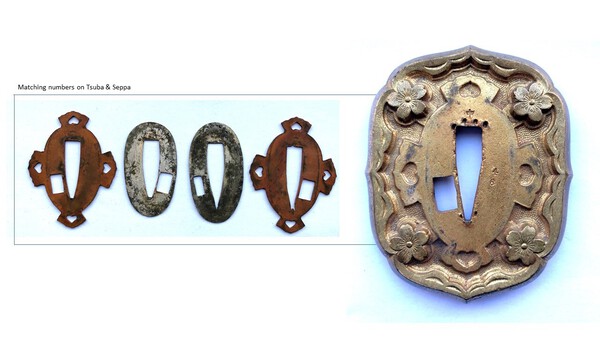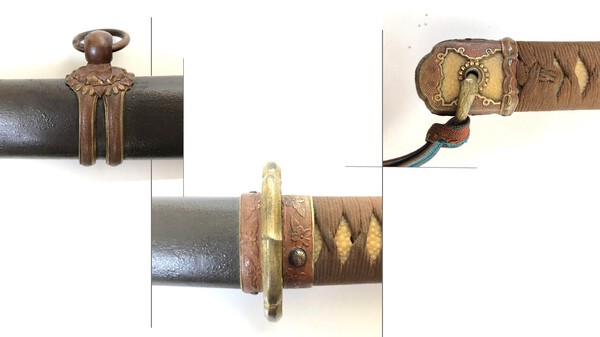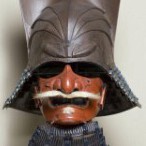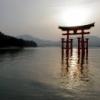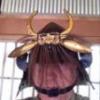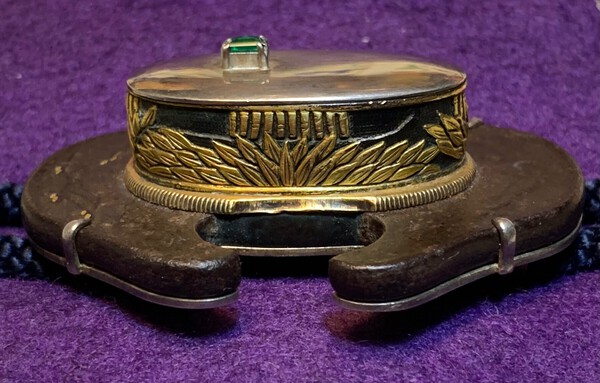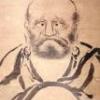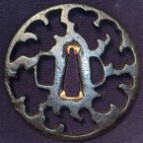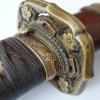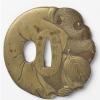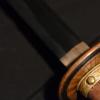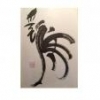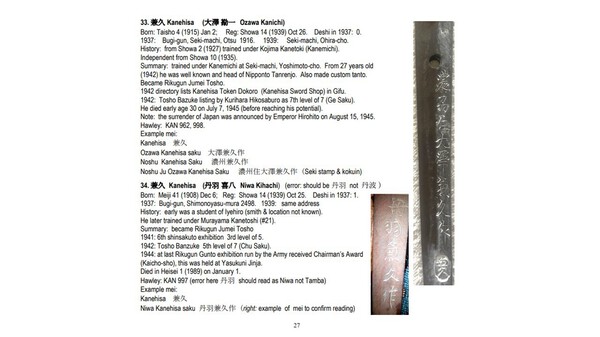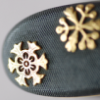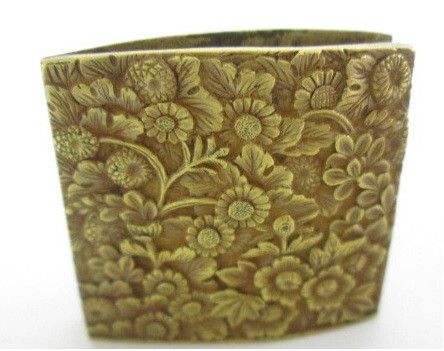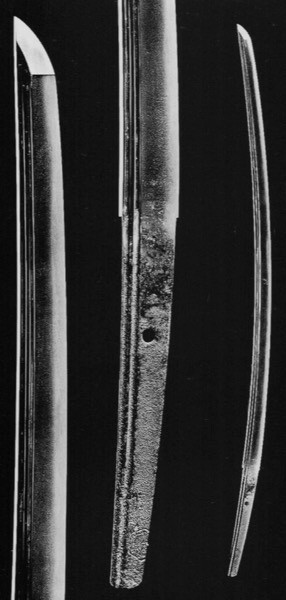Leaderboard
Popular Content
Showing content with the highest reputation on 02/21/2022 in all areas
-
Update. Good news Released from customs with a 160 quid charge. Compared to the 4k that is a breath of fresh air. And i can try to get the 160 back with bor form. I agree with Tom. Its luck and who deals with it, not necessarily what you always put on there. The fact that my paperwork was accepted but somebody got the calculations wrong and took the wrong currency and put a charge of 4k was heart failure material. Fingers crossed now I can collect from depot Wednesday. It's crazy that in the past I imported two iaitos from Japan without problem ! And the reason was I was a member of the BKA. But I'd imagined that an antique would be easier.5 points
-
4 points
-
Erwin your assembling needs just re-work. The small seppa to tsuka side then the boars eye seppa. From swordside the same. The red seppa is allways the first on the tsuba. Nice presentation btw. 👍4 points
-
Item No. 202 Tsuba in sentoku with copper , gold and shakudo 7.13 cm x 6.58 cm x 0.49 cm Subject of eagle hunting a monkey. Signed Hirochika ( Haynes 01300.0 )( Thanks, George ) - Mito school , early 19th cent. Fine detailing with tiny inlays of shakudo ( eagle's talons ) , golden eye and shading above the eye . See Item No. 119 for a different version of the same subject by Hiroyoshi , also Mito school. In fact , both the maker of this piece - Hirochika - and Hiroyoshi were in the Mito school and are shown next to each other in Sesko's Genealogies - it is tempting to speculate that in real life they may have occupied adjoining work spaces also and co-operated whilst producing the same design...4 points
-
Hi I just like to add a couple of points that may help other buyers When a seller has multiple items for sale I cut and paste the description of the item of interest in my PM I may ask for extra images or any details to help me decide If I’m 100% sure of a purchase I ask for a total and their email for a PayPal payment and pay using the ‘friends’ option Once paid I send my address and any delivery instructions as I always as the package to be tracked and signed for where possible and a copy of the tracking number It only takes minutes to send a payment On delivery I contact the seller to say it has been delivered I buy quite a few items, so sellers know my reputation One follow up example from a few days ago I expressed and interest to buy (as I needed to check my funds) within four minutes of seeing the selling post They PMed me back saying I was first in line, but two others wanted t buy so three buyers with 30 minutes It was a no brainer, and I confirmed my wish to buy and paid immediately A seller expecting payment not delaying statements4 points
-
4 points
-
You're embarrassing yourself. I'd say more than 80% of "I'm interested" inquiries never become a sale. Take this from someone who has sold over 1000 knives on FB and forums. "I'm interested means I want to haggle, I am not willing to commit yet, and I want a back and forth debate first. "I'll take it" .... THAT is a commitment. Use it...don't use it. One of those will get you more items in the future.3 points
-
About a year ago at a local gun show I acquired a “Chinese polearm.” It was a boredom buy since I really have neither interest nor knowledge of Chinese weapons, but I think this is of a type that is commonly called a ‘Dao’. It came with no history and truly can be described as “in relic condition.” It sat quietly in a closet until last week when I began thinking – yet again – about “Namban sword guards” which, of course, includes a great range of Southeast and East Asian, European, and Japanese fittings that were re-purposed, traded, and variously mixed. In thinking about that topic, I decided that the best element on the Dao was its lobed guard that seems comparable to “early” Japanese tsuba. The flow of arms between Japan and China is well known. To study that fitting, I set about disassembling the pole arm. I assumed that experience with Japanese arms would offer a basis for this activity. What I discovered was the importance of “MEKUGI” the bamboo pins that hold Japanese blades together. I also came to the conclusion that Chinese construction seems to have been significantly different – and less refined – than Japanese techniques. The tang of the Dao blade was rather loosely set in an open groove in the short section of pole still present. It looks like the pole had been sawed off just beyond the end of the tang. In addition to 4 forged iron rings, the tang was held in place by two (2) iron pins. Based on experience with Japanese polearms, I assumed that these would be comparable to the bamboo pins used in Japan and that they would be removable. In fact, I discovered that the iron pins were essentially fixed. They seemed to have become solidly “rusted” on to the Dao tang. Even heavy (but careful) pounding would not loosen them. Having committed to the project, I decided to cut the iron pin with a thin blade Dremel tool. The take away message may be that bamboo mekugi allowed Japanese blades to be removable, and therefore survivable. Are they, in fact, the real secret behind Japanese blades? Peter2 points
-
I think the point here is that any seller with original Nanbokucho koshirae to an original Nanbokucho, ubu sword isn't going to get Tokubetsu hozon and chill, they're going for full status and that's juyo minimum just on rarity alone.2 points
-
Forgot to answer the screw question. One is flat head the other round head, two different thread pitches. Both look like someone had their 12 year old kid practice grinding one day. threads are 75% gone, both ground to a minor taper.2 points
-
I've collected militaria off and on for 45 years so I know the "buy the item not the story" routine. What got me started was all the stuff my father both sent & brought back during his service from 44-46 most with the 7th division. After landing at Inchon he eventually ended up in the 7th signal company and eventually the 7th signal co supply as supply sergeant(Korea occupation). The most valued thing I own is a shoe box stuffed full of most of the letters he wrote to his parents. It still amazes me how much he either shipped home or packed in his duffle. The items he had and couldn't get home is even more incredible. More on all that in the future. As supply sergeant he would be tasked with requisitioning souvenirs for troops heading home. Contrary to what some believe official orders regarding souvenirs changed several times. By spring/summer 46 as things loosened if a dozen guys were leaving he would go to the depo where all the capture weapons were(a gym at the former Japanese barracks) and get 2 swords, 8-10 rifles, a few helmets, and a handful of bayonets. Needless to say he got to know the guys at the depot and was in a position to help them with regular supply items. He was given two swords and two rifles (one each at different times) from the ""hand picked"" rack behind the desk. He said this one was the only black lacquered scabbard in good shape plus it had a tassel and the best part,,,,,,,,,,,,a silk scarf with what I assume is the original owners information tied to the sword. I will post a pic soon. With all that said I can say with confidence nobody has touched this or the type 95 I will post since 1946. One last tidbit. He coated the blades with Vaseline before shipping them home. He recoated them again back in the late 70's and they still look great.2 points
-
2 points
-
2 points
-
2 points
-
2 points
-
First time on the site. Looking forward to a lot of reading and learning. I would like to find out as much as possible about this sword and another I will post soon. I feel very lucky to know where both of my swords came from and in the case of this one, who the owner was. This one had not been disassembled until I did it a few days ago. Before someone says DON'T ...............I already cleaned the lose rust off with Hoppe's and a soft brush. There is still plenty of rust. The scabbard is black lacquered wood. It also came with this tassel. The handle wrap looks like a rope material dipped in dark red paint. I'll take some relatively uneducated guesses for fun and see what the experts come back with. I look forward to you confirming or correcting each of my assumptions. }}} I think it was remounted late in the war? }}} Many of the small parts appear mass produced? The Tsuba and spacers have a stamping of 310. }}} The blade appears to be re-drilled for the new handle? The upper hole is somewhat oblong. }}} The green paint characters are either a serial number or the person/company that did the remount? Thanks,1 point
-
I found some online vague references to a pig-dragon. There is a goat-dragon, but it has goat horns. Maybe someone more versed in Japanese mythology can help us!1 point
-
On the turtle i think it is damage. Someone tried to remove the habaki from a sword and hammered on it. Its sad. The Turtle and the Horsedragon is the same habaki. The design is on each side. Its the only Horsedragon i ever found. I see this creature not twice. Or is it a Dragon with goat feet? In Bavaria we would say it looks like a "Wolperdinger"1 point
-
The issue with the green papers is that the Yakuza were leaning on shinsa panels at NBTHK branch shinsa to pass gimei blades. Consequently, a sword with these papers attributed to a big name smith should be treated as though unpapered.1 point
-
Well, On the CAST side of things: -uniform colour everywhere (which is often some version of a uniform "grey" colour, but sometimes a "waxy-looking" black in some types of the more obvious cast tsuba). -the mimi and seppa-dai are definitely dimpled with little sand-grain-like craters. -there are some surface irregularities in the waves on the omote (front) side that has the majority of the anchor on it. And I mean the plate itself, underneath the fine wave lines. On the HAND-WORKED side of things: -the inlayed "water droplets". -there appears to be a few stray chisel marks (or maybe it's just damage?) on the ura (back) side's mimi at the 2 o'clock and 4 o'clock positions. On the "ambiguous" side of things (for me): -there appears to be some streaky "flow patterns" around the mimi on both faces of the tsuba, as well as all along the inner, sunken "step" the runs along the inside of the mimi. *could be indicators of "poured fluid" or indicators of the layers of a "folded plate", but it seems too streaky to be the folded layers. Especially so for the inner, sunken "step" along the mimi. If that was punched down with a punch, it would be a lot smoother than that, and a chisel would leave different looking marks as well. So, overall it looks more like it was poured fluid. Overall, I'm leaning towards initially CAST, then hand finished. I personally don't know if casting can produce such fine ridge lines. And, just throwing out a guess about the overall process here: Maybe the tsuba was cast, then inlayed with the water droplets, then the wave ridges were chiseled in by hand afterward? The timing of when the wave ridges were produced is an unknown for me. An interesting example Dan1 point
-
Hi All, It seems luck has a lot to do with it, I ordered a sword 3 weeks after Paz from Aoi art , on the advice of Paz I asked them to include the sword description and invoice with the paperwork My sword arrived in customs UK on Friday morning, after reading this thread I was feeling very nervous about the whole thing , but when I checked this morning it was out for delivery and arrived today , no forms or anything. Very happy , very lucky Tom1 point
-
Thank you Vajo for pointing this out, much appreciated. Re-assembled without thinking i am afraid, will re-work it later today best regards Erwin1 point
-
1 point
-
Hi Bruno, I was not expecting a masterpiece at all. I try to read the mei to improve my skills. I bought the kozuka because I liked the design and the price was right. Not because it was signed. For me personally buying high end items is risky and out of reach. Thanks for all the information provided.1 point
-
There are 2 Nara Toshinaga listed in Haynes, H10469 (Son of Toshiharu) considered as the 3rd master of the Nara family school (Big name) and H 10473, son of the previous one . More information on: https://yuhindo.com/nara-tsuba/1 point
-
Hello Erwin, Well done,Very nice all round package and good photo’s.... Regards, Paul..1 point
-
If that first character is an artistic way of writing 奈 Na of 奈良 Nara, then the rest is as you say, Ed.1 point
-
Hi Darkcon, I can't say anything about a reliable service provider from the USA. Otherwise try to describe the content as good as possible, ideally also with German translation and attach an invoice. As a rule, since the middle of last year, Deutsche Post has taken over customs clearance. They need clear information about the content and value of the shipment. It is also good if a telephone number and/or e-mail address of the recipient is given, then the process runs faster in case of inquiries. By the way, customs clearance via Deutsche Post seems to work only with an import VAT rate of 19%, no matter how old or collectible you describe the sword. I currently have appeals against my notices to run for the import VAT charged. There are also lawsuits already pending in this regard. But as I said, this is not your problem.1 point
-
You can read about much of it in the article Thomas liked above, but most of that is described in word form. I'll look the survey over and see if I can post some interesting charted tidbits.1 point
-
1 point
-
David, Not sure where you are located in the US - Are you planning on attending the Chicago show in April? I am the current custodian of this tachi: https://nihontoart.com/shop/tachi-signed-akikuni/, and could bring it to the show for you to examine if you are interested. While not Nanbokucho, it is from the Oie period (1394 to 1429), Tokubetsu Hozon, 74.9 cm, and Edo koshirae. (My apologies to Nick for referencing his excellent website photos; my photography skills are decidedly lacking!) Dan K.1 point
-
Hello - the same smith as is in the thread below 酒向兼茂作 Sakō Kaneshige saku (means: "made by Sakō Kaneshige)1 point
-
Wow that looks even higher from the side, nicely edged seppa as well- plenty of spare parts! You need to get that stone seen by a jeweller, it might be an Emerald or just Tourmaline.1 point
-
Nanbokucho tachi but with nagasa of “only” 71cm as a bit suriage, vs your desired 72cm: https://www.aoijapan.com/katana-mumei-kashu-kagemitsu/ Rather than focus only on period and length, would be worthwhile to figure out school too.1 point
-
1 point
-
I think that more photos are in order and it might be an interesting piece. I don't think that the mei was added recently. In such a case, there is usually red rust in the carving of the mei, and this tanto doesn't have that. Having half a date is odd, but it would be nice to see the whole tang and the whole sword.1 point
-
In the Swordsmith Index of the website, I found the below information. This is the closest to the signature that is on my yari - SANSHU YOSHIDA RAI KANEFUSA. Would it be reasonable to assume that the signature on my spear is a shortened version of what is below? Kanefusa ID KAN755 Province Mikawa Era Jōō (1652-1655) Active Period 1652-1655 Source Rating Reference/Page Hawley 15 KAN755 Signatures: 三州吉田住藤原来兼房 sanshū yoshida ju fujiwara rai kanefusa 三州藤原来兼房 sanshū fujiwara rai kanefusa1 point
-
The one I downloaded came from the thread Any help would be appreciated . Here is another one for the database that comes from Hot Stamp .1 point
-
I don't know which specific Kaneshige is yours (there were Morita, Murayama and perhaps others) but this looks like the same hand:1 point
-
It seems allways a star stamped gendaito in these fittings. Great. Thats a fine sword Eric. Its a true nihonto not massed produced.1 point
-
1943 Contingency model (Rinji seishiki) of the Type 98 Officers sword.1 point
-
1 point
-
Here's your man. We were just talking about this smith the other day. https://www.militaria.co.za/nmb/topic/38633-new-acquisition-need-help-please/#comment-400292 亮信 Akinobu, a.k.a. Sukenobu1 point
-
As posted on Reddit, it means that Kaneshige, resident of Noshu (Mino Province) made this. He's a wartime smith. Not sure, but may be this smith:1 point
-
One thing for sure - you're going to wind up with a really firm grasp of what looks right and what looks wrong by the time you get done with it!1 point
-
1 point
-
1 point
-
1 point
-
In the real world I generally agree with you Kirill. It seems that this tanto may have some sort of fabricated provenance though. I would like to know a bit more about what that provenance is (verbal, origami, etc). I do not see it outside the realm of possibility that an aoi-mon was added to support a claim of Tokugawa denrai, but the details around this sword are unclear. We do see that aoi-mon appear as a sort of 'marketing gimmick' on the koshirae of many low-quality, late export pieces. Photo of the Kokuho Kikkou Sadamune attached (亀甲貞宗). Once a possession of the Owari Tokugawa, the mon on the nakago is believed to be associated with ownership of the sword.1 point
This leaderboard is set to Johannesburg/GMT+02:00



